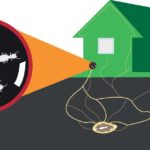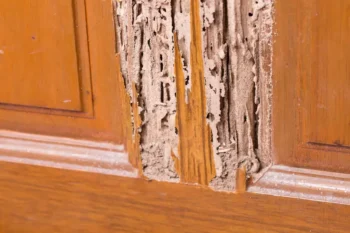
When warm weather returns in the spring, a surge in insects that damage wood like termites, carpenter ants, and carpenter bees occurs. Understanding the risk is crucial to avoid damage to your home.
What Are White Ants?
White ants do not exist. Ants can be red, brown, or black, but not white. When people see a “white ant,” it is really a termite. Unfortunately, over time the term “white ant” has become another way people refer to termites, which confuses things further.
Are White Ants Dangerous?
“White ants” – which are actually termites – are harmful to your property, not to people. Termites themselves neither bite people nor carry disease. However, a termite infestation can trigger allergies and asthma attacks due to the increased level of irritants in the air due to the wood damage they cause.
Are White Ants and Termites the same thing?
Yes! What people call white ants are termites. A termite can come in one of three varieties – dry wood, wet wood, and subterranean.
Dry wood termites are not common in the United States. The damp wood termite is usually found in heavily forested areas… so they are not usually an issue on Long Island.
Subterranean termites are a threat on Long Island and, unfortunately, the most destructive type of termite. They need the dampness of living in soil, which is another common misunderstanding. People assume termites live in the wood beams because they devour it. Instead, they make a colony in the dirt outside the home and use mud tubes to travel from the colony to the wood they are infesting.
Signs of White Ants/Termites Are:
- Sound. Termites make a clicking sound that can sometimes be heard within the wood.
- Hollow Sounding Wood. If you tap a piece of wood or a beam and hear a hollow sound, it is almost always an indication of a termite infestation.
- Flying Termites. Termites fly when they’re ready to mate.
- Difficult to Open Doors and Windows. Moisture from the termite activity can warp window and door frames, making them hard to open and close.
- Mud Tubes. Some people have referred to mud tubes as a “termite highway” because they construct and use them to travel from their subterranean homes and the wood they devour. Mud tubes are a clear sign of a termite or “white ant” infestation, and that it is time for termite treatment.
However, termites are not the only insect that damages wood. Carpenter ants and carpenter bees (sometimes nicknamed “wood bees”) are also an issue.
When Should I Worry About Carpenter Ants?
Any sign of carpenter ant activity in your home is a problem that should be addressed quickly for the simple fact that they might have been active for a while already. The longer you wait to act, the more damage they can do. Since property damage from wood-harming insects is usually not covered by insurance, greater damage means more expense.
Can Carpenter Ants Eat Brick?
Carpenter ants do not eat brick in terms of devouring it for nutrition reasons. However, carpenter ants do seek out cracks in mortar and concrete as ways to get to wood, which makes some people think they eat mortar, brick, or concrete.
Similarly, carpenter ants and termites will chomp on mortar and concrete to cause cracks so they can infest a building. That is not eating the mortar or concrete in the usual fashion but can give the wrong impression.
Also, concrete and mortar can be more fragile than you think. Powerful carpenter ant and termite mandibles can bite it in an effort to create cracks that provide access to the wood inside.
How Do You Fix Carpenter Bee Holes?
The first step is to determine if they are active carpenter bee holes or abandoned ones. If still active, carpenter bee treatment is necessary first.
After carpenter bee (sometimes nicknamed “wood bees”) treatment, or if the holes are abandoned, the holes can be filled with steel wool or wadded up aluminum foil, wood glue, or caulk. Then paint over the filled holes.
Arrow Can Protect Your Home from Termites
Termites, carpenter ants, and carpenter bees can cause severe damage to your home. If you suspect a problem, call or contact the professionals at Arrow Exterminating to identify and eliminate them. For more information, schedule a consultation today.






